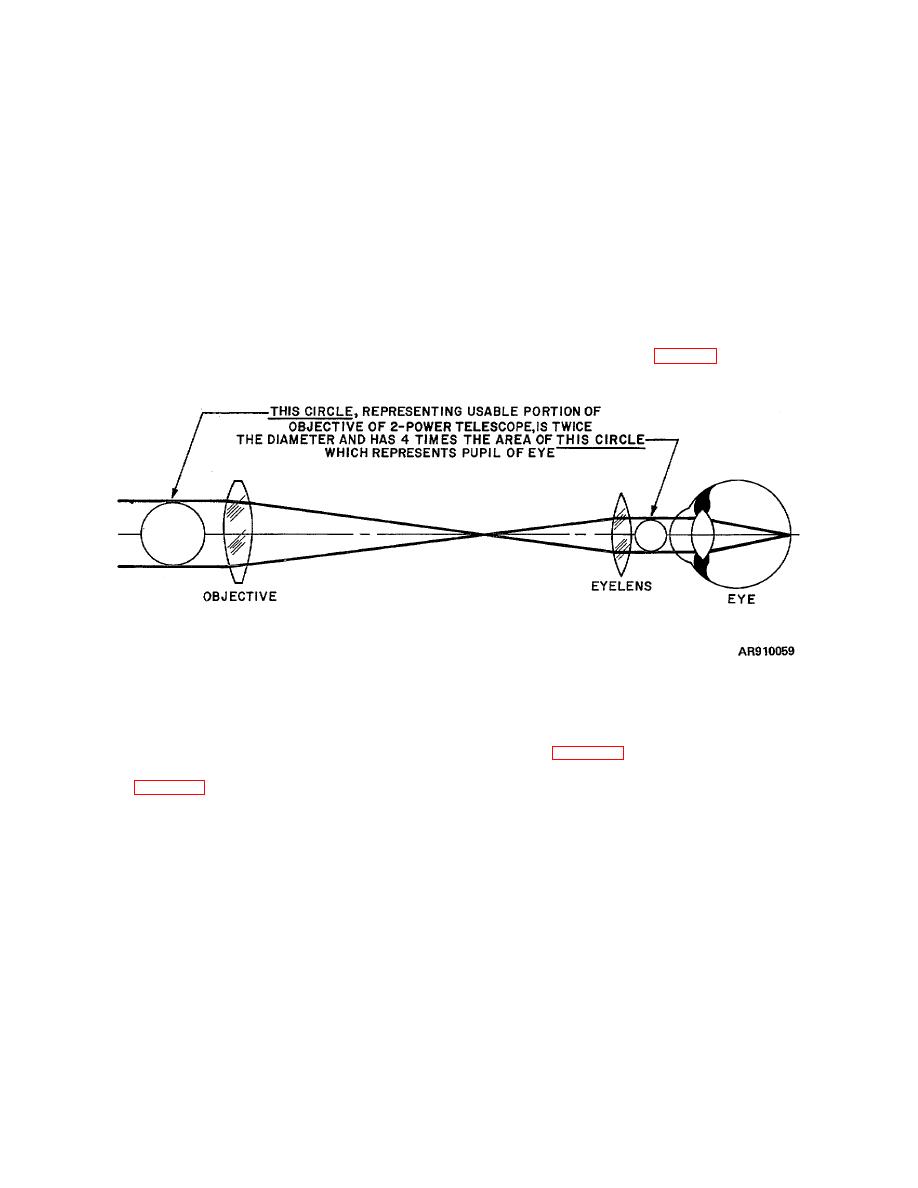 |
|||
|
|
|||
|
Page Title:
Figure 2-53. Comparison of light entering eye with 2-power telescope. |
|
||
| ||||||||||
|
|
 TM 9-258
c. An apparent field of view of approximately 450
2-33. Brightness of Image.
may be considered as a practical maximum for a highly
a. Brightness of Image and Exit Pupil. The more
corrected eyepiece. Thirty--five or 400 is a more
light that can be brought from each point of the object to
common value and in the more simply constructed
the eye, the brighter will be the image that is formed.
eyepieces the field may be only 250 or 300. This
This characteristic is known as brightness of image. The
apparent field of view, divided by the power of the
point where the image is brought to the eye is called the
eyepiece, determines the maximum value of the true
exit pupil of the instrument.
field for any given magnification. For example, if an
b. Magnification and Brightness. When one looks
eyepiece corrected for an apparent field of 400 is used
at very distant objects with the naked eye, almost parallel
and a telescope of 10-power is required, the maximum
rays of light enter the pupil of the eye and form an image
true field of the instrument would be only 4.
of a certain size on the retina. When one uses a
d. Other factors can further limit this maximum true
telescope of 2-power magnification, the light forms an
field. The components of the erecting system of the
image on the retina which is twice as high and twice as
instrument might not be sufficiently large to transmit the
wide or an image that covers four times the area of the
full useful area of the image and would decrease the
image that would be formed by the naked eye of the
field. Some aperture in the instrument might be so small
same parts of the objects (fig 2-53).
as to restrict the field.
Figure 2-53. Comparison of light entering eye with 2-power telescope.
c. Loss of Light. There is always a considerable
diameter is from 1/4 to 3/10 inch. A telescope or other
instrument for use at night should have an exit pupil
loss of light by absorption and by reflections at the
aperture (fig. 2-54) of this size. The aperture of the
surfaces of the lenses. While this loss may be as great
objective must then be sufficiently large (1/4 to 3/10 inch
as 75 percent, every effort is made to reduce the loss to
times the magnification of the instrument) to insure that
a minimum (para 4-13).
d. Objective Aperture. A contributing factor in
the pencil of light will fill the pupil of the eye. During the
daytime, the useful aperture of the objective of such an
brightness of image is an objective lens aperture (usable
instrument is correspondingly smaller.
portion) large enough to permit the eyelens to produce
f. Sacrificing Brightness of Image. Some of the
an emergent beam that will fill the pupil of the eye. On
telescopes used for military fire control purposes are
the other hand, enlarging the objective beyond this point
made with objective smaller than that indicated by/this
affords no greater brilliance because additional light is
formula. Brightness of image has been sacrificed to
prevented by the iris from entering the eye.
e. Exit Pupil Aperture. During the day, the pupil of
obtain a more compact instrument.
g. Aperture Ratio of Camera Lens. This is
the eye is from 1/10 to 2/10 inch in diameter. At night,
the pupil may dilate until its
2-40
|
|
Privacy Statement - Press Release - Copyright Information. - Contact Us |